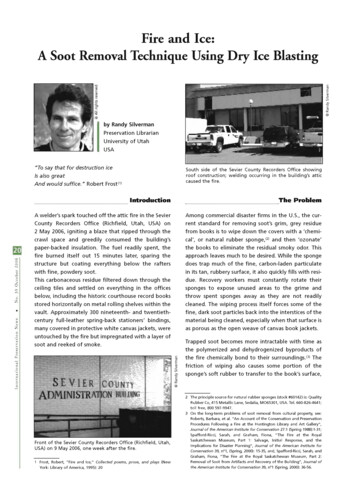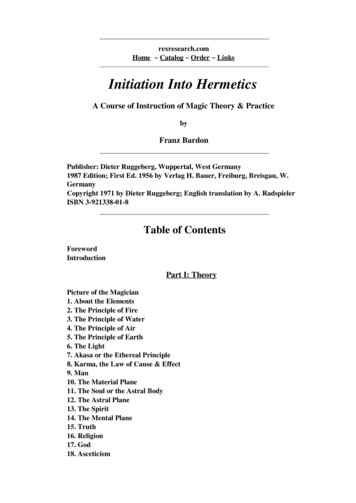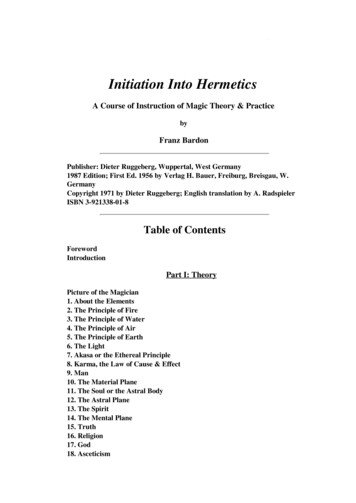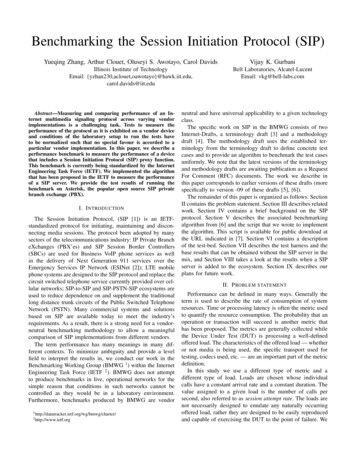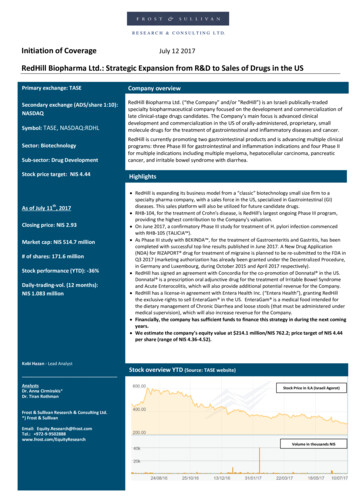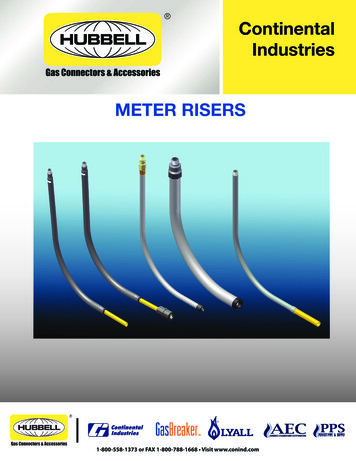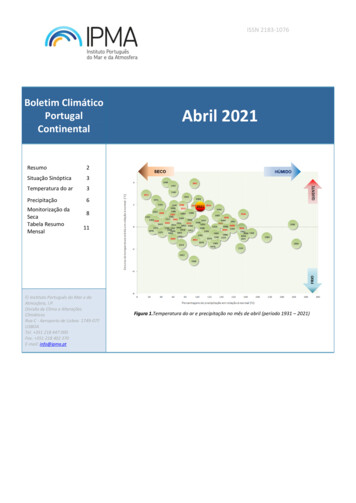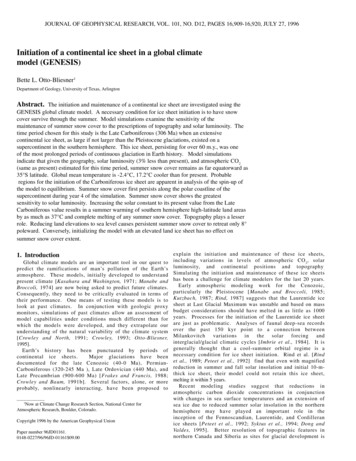
Transcription
JOURNAL OF GEOPHYSICAL RESEARCH, VOL. 101, NO. D12, PAGES 16,909-16,920, JULY 27, 1996Initiation of a continental ice sheet in a global climatemodel (GENESIS)Bette L. Otto-Bliesner1Department of Geology, University of Texas, ArlingtonAbstract. The initiation and maintenance of a continental ice sheet are investigated using theGENESIS global climate model. A necessary condition for ice sheet initiation is to have snowcover survive through the summer. Model simulations examine the sensitivity of themaintenance of summer snow cover to the prescriptions of topography and solar luminosity. Thetime period chosen for this study is the Late Carboniferous (306 Ma) when an extensivecontinental ice sheet, as large if not larger than the Pleistocene glaciations, existed on asupercontinent in the southern hemisphere. This ice sheet, persisting for over 60 m.y., was oneof the most prolonged periods of continuous glaciation in Earth history. Model simulationsindicate that given the geography, solar luminosity (3% less than present), and atmospheric CO2(same as present) estimated for this time period, summer snow cover remains as far equatorward as35 S latitude. Global mean temperature is -2.4 C, 17.2 C cooler than for present. Probableregions for the initiation of the Carboniferous ice sheet are apparent in analysis of the spin-up ofthe model to equilibrium. Summer snow cover first persists along the polar coastline of thesupercontinent during year 4 of the simulation. Summer snow cover shows the greatestsensitivity to solar luminosity. Increasing the solar constant to its present value from the LateCarboniferous value results in a summer warming of southern hemisphere high-latitude land areasby as much as 37 C and complete melting of any summer snow cover. Topography plays a lesserrole. Reducing land elevations to sea level causes persistent summer snow cover to retreat only 8 poleward. Conversely, initializing the model with an elevated land ice sheet has no effect onsummer snow cover extent.1. IntroductionGlobal climate models are an important tool in our quest topredict the ramifications of man’s pollution of the Earth’satmosphere. These models, initially developed to understandpresent climate [Kasahara and Washington, 1971; Manabe andBroccoli, 1974] are now being asked to predict future climates.Consequently, they need to be critically evaluated in terms oftheir performance. One means of testing these models is tolook at past climates. In conjunction with geologic proxymonitors, simulations of past climates allow an assessment ofmodel capabilities under conditions much different than forwhich the models were developed, and they extrapolate ourunderstanding of the natural variability of the climate system[Crowley and North, 1991; Crowley, 1993; Otto-Bliesner,1995].Earth’s history has been punctuated by periods ofcontinental ice sheets.Major glaciations have beendocumented for the late Cenozoic (40-0 Ma), PermianCarboniferous (320-245 Ma ), Late Ordovician (440 Ma), andLate Precambrian (900-600 Ma) [Frakes and Francis, 1988;Crowley and Baum, 1991b]. Several factors, alone, or moreprobably, nonlinearly interacting, have been proposed to1Now at Climate Change Research Section, National Center forAtmospheric Research, Boulder, Colorado.Copyright 1996 by the American Geophysical UnionPaper number 96JD01161.0148-0227/96/96JD-01161 09.00explain the initiation and maintenance of these ice sheets,including variations in levels of atmospheric CO 2 , solarluminosity, and continental positions and topography .Simulating the initiation and maintenance of these ice sheetshas been a challenge for climate modelers for the last 20 years.Early atmospheric modeling work for the Cenozoic,particularly the Pleistocene [Manabe and Broccoli, 1985;Kutzbach, 1987; Rind, 1987] suggests that the Laurentide icesheet at Last Glacial Maximum was unstable and based on massbudget considerations should have melted in as little as 1000years. Processes for the initiation of the Laurentide ice sheetare just as problematic. Analyses of faunal deep-sea recordsover the past 150 kyr point to a connection nterglacial/glacial climatic cycles [Imbrie et al., 1984]. It isgenerally thought that a cool-summer orbital regime is anecessary condition for ice sheet initiation. Rind et al. [Rindet al., 1989; Peteet et al., 1992] find that even with magnifiedreduction in summer and fall solar insolation and initial 10-mthick ice sheet, their model could not retain this ice sheet,melting it within 5 years.Recent modeling studies suggest that reductions inatmospheric carbon dioxide concentrations in conjunctionwith changes in sea surface temperatures and an extension ofsea ice due to reduced summer solar insolation in the northernhemisphere may have played an important role in theinception of the Fennoscandian, Laurentide, and Cordilleranice sheets [Peteet et al., 1992; Syktus et al., 1994; Dong andValdes, 1995]. Better resolution of topographic features innorthern Canada and Siberia as sites for glacial development is
OTTO-BLIESNER: CONTINENTAL ICE SHEETalso critical [Dong and Valdes, 1995]. Recent modelingstudies suggest that the Laurentide ice sheet probably initiatedon high regions of Baffin Island and that improvement in theresolution of this topographic feature plus the use of a icesheet model may lead to a successful simulation of glacialinitiation.The mechanisms for the initiation, maintenance, andeventual demise of Permian-Carboniferous glaciation has beenextensively studied with energy balance models and morerecently using global climate models. Crowley et al. [Baumand Crowley, 1991; Crowley et al., 1994] find that small icecap instability (SICI) associated with snow-albedo feedback,previously demonstrated in simple models of the climatesystem as a possible mechanism for glacial inception, is alsoa feature of more complex global climate models whichexplicitly include the hydrologic cycle. Under cold-summerorbital conditions, a reduction in solar luminosity by 0.5%from 98.5% to 98% of present levels results in a dramaticincrease of over 35 X 10 6 km 2 in simulated summer snowcover, roughly comparable to the estimated size of thePermian-Carboniferous ice sheet.Energy balance modelresults [Crowley and Baum, 1992] suggest that the demise ofthis ice sheet is tied to increasing levels of atmospheric CO 2interacting with changing paleogeography.Crowley andBaum [1993b] also find that Milankovitch cycles can force theglacial-interglacial fluctuations in climate that have beenproposed as a possible explanation for records of cyclicalPermian-Carboniferous sea level fluctuations.The Late Ordovician (440 Ma) glaciation poses a climaticparadox for glacial maintenance in that atmospheric CO 2 washigh, estimated to be 13 times present. Crowley and Baum[1995] reconcile this paradox by demonstrating that theposition of Gondwana tangential to the south pole incombination with reduced solar luminosity is sufficient toinitiate and maintain the polar ice cap found in the rock record.The low thermal inertia of the nearby polar oceans is sufficientto cool summer temperatures of the adjacent land areas andallow accumulation of snow and ice.Late Precambriansimulations [Crowley and Baum, 1993a] illustrate that theresponse of modeled snow line to reduced solar luminositydepends on choice of paleogeography.A supercontinentlocated entirely in tropical latitudes will not trigger icegrowth. Land areas at midlatitudes provide the “seed” area forsummer snow cover and thus ice growth into lower latitudes.In this study, the sensitivity of ice sheet initiation toseveral factors is considered. In particular, the ability of themodel to retain summer snow cover over middle- and highlatitude land is assessed as a function of land elevation andsolar luminosity given the land-sea distribution at 306 Ma.Results from the spin-up phase of the model as well as themean climate for years 14-18 of the simulations are presented.2. Details of Numerical ModelA set of sensitivity simulations for the Late Carboniferousis conducted using the National Center for AtmosphericResearch (NCAR) GENESIS global climate model, version1.02 [Thompson and Pollard, 1995a, b]. The model consistsof components for the atmosphere, ocean, and land surface.The atmospheric component is based on the NCAR communityclimate model version 1 (CCM1). The atmosphere is describedby the equations of fluid motion, thermodynamic equation, andmass continuity along with representations of radiative andconvective processes, cloudiness, precipitation, and theorographic influence of terrain. The CCM1 code has beenmodified to incorporate new model physics for solar radiation,water vapor transport, convection, boundary layer mixing,and clouds.The horizontal resolution is R15 whichcorresponds to a 4.5 latitude by 7.5 longitude spectraltransform grid, on average. A s-coordinate system is used inthe vertical with 12 levels from s 0.991 to 0.009.The ocean component of GENESIS contains a 50-m-deepmixed layer ocean coupled to a thermodynamic sea ice model.The ocean representation crudely captures the seasonal heatcapacity of the ocean mixed layer but ignores salinity,upwelling, and energy exchange with deeper layers. Polewardoceanic heat transport in present-day simulations is set to be0.3 times the latitudinal variation from the “0.5 x OCNFLX”case of Covey and Thompson [1989] . A six-layer sea icemodel, patterned after Semtner [1976], predicts local changesin sea ice thickness through melting of the upper layer andfreezing or melting on the bottom surface. Fractional sea icecoverage is included, as is a reduction in the albedo as thesurface temperature of the sea ice approaches 0 C.The land surface component [Pollard and Thompson, 1995]incorporates a land-surface transfer model (LSX) whichaccounts for the physical effects of vegetation, a six-layer soilmodel that diffuses heat linearly and moisture nonlinearly witha provision for soil ice, and a three-layer thermodynamic snowmodel. Snow cover can form on soil, ice sheets, and sea icesurfaces with changes in thickness due to snowfall andsublimation at the top layer and melting in each layer. Aminimum snow thickness of 15 cm is imposed with fractionalsnow cover allowing for conservation of snow mass. Snowfalls when the temperature is below freezing at the lowestatmospheric level. The average albedo of the snow variesfrom 0.75 for topmost snow-layer temperatures below -15 Cto 0.55 at 0 C (e.g., wet snow). The effects of snow aging areignored. Permanent land ice can be prescribed as a surface typein the model. As such, it cannot grow or ablate. The albedo ofa snow-free ice sheet surface is the same as for sea ice. Theaverage albedo varies from 0.65 for topmost layertemperatures below -5 C to 0.55 at 0 C. In present-daysimulations, land ice is prescribed over Greenland andAntarctica.The GENESIS model adequately reproduces observedpresent-day climate [Thompson and Pollard, 1995a]. Globaland annual mean surface temperature is predicted to be 14.7 C,which is slightly warmer than observed estimates of 13.9 C.Much of this error is due to the model being too warm at thesurface over Antarctica, land areas in high northern latitudes,and the topographic regions of the Andes, Rocky Mountains,and Greenland.The latitudinal location of the freezingisotherm over land and its seasonal migration match observeddata.The model’s global and annual mean precipitation (4.5 mmd -1) is considerably greater than observed (3.2 mm d -1). Thisoverestimate occurs over both land and ocean and has beencorrected in a newer version of GENESIS with decreased surfacedrag over oceans. Broad-scale patterns of precipitation aresimulated correctly including the seasonal movement of theIntertropical Convergence Zone (ITCZ), the dry subtropics,and dry interior continents at middle and high latitudes inwinter.The model snow line compares favorably to observation,except for too little snow cover between the Black and the
OTTO-BLIESNER: CONTINENTAL ICE SHEETCaspian Seas and too much just north of the Himalayas. Theseasonal cycle of total snow mass and coverage over Eurasiaand North America agree with the climatology derived fromsatellites. Over the ice sheets of Greenland and Antarctica themodel produces a net annual accumulation of snow asobserved.3.2. Ice Sheet and Snow CoverGlacial deposits (tillites) dated to the Late Carboniferoushave been found on the continents of Australia, Africa, SouthAmerica, and Antarctica as well as India [Crowell, 1983;Caputo and Crowell, 1985; Veevers and Powell, 1987] andsuggest the possibility of four ice sheets with total arealextent of 18 X 10 6 km 2 [Crowley and Baum, 1991a]. A more3. Climate Sensitivity Simulationsextensive single ice sheet covering nearly 70% of thecontinent of Gondwana from the south pole to roughly 45 SThe maintenance and initiation of the Late Carboniferous latitude and with areal extent of 42 X 10 6 km 2 has beenice sheet are examined in a series of sensitivity simulations proposed by C.R. Scotese and J. Golonka (personalexploring the effects of (1) two different land elevations, (2) communication, 1994), (Figure 1). The rationale for a singletwo different solar luminosities, and (3) prescribed land ice massive ice sheet assumes extensive destruction of glacial(ice sheet) from the south pole to approximately 45 S. The evidence, especially during highly erosional postglacialbaseline Carboniferous simulation (hereinafter referred to as environments. This massive ice sheet is prescribed in the full“no-ice”) is performed with no prescribed ice sheet (e.g., bare ice simulation (Plate 1) and ice sheet heights ranging up to 3soil initially), land elevations ranging from 500 to 3000 m, km are assigned using the area-volume relationship employedpresent-day atmospheric CO 2 levels, and solar luminosity 3% in the Climate Mapping, Analysis, and Prediction (CLIMAP)less than
Bette L. Otto-Bliesner1 Department of Geology, University of Texas, Arlington Abstract. The initiation and maintenance of a continental ice sheet are investigated using the GENESIS global climate model. A necessary condition for ice sheet initiation is to have snow cover survive through the summer. Model simulations examine the sensitivity of the maintenance of summer snow cover to the .
